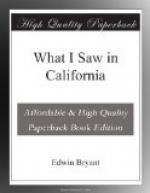Mr. Marshall, to save labour, let the water directly
into the race with a strong current, so as to wash
it wider and deeper. He effected his purpose,
and a large bed of mud and gravel was carried to the
foot of the race. One day Mr. Marshall, as he
was walking down the race to this deposit of mud, observed
some glittering particles at its upper edge; he gathered
a few, examined them, and became satisfied of their
value. He then went to the fort, told Captain
Sutter of his discovery, and they agreed to keep it
secret until a certain grist-mill of Sutter’s
was finished. It, however, got out and spread
like magic. Remarkable success attended the labours
of the first explorers, and, in a few weeks, hundreds
of men were drawn thither. At the time of my
visit, but little more than three months after its
first discovery, it was estimated that upwards of four
thousand people were employed. At the mill there
is a fine deposit or bank of gravel, which the people
respect as the property of Captain Sutter, though
he pretends to no right to it, and would be perfectly
satisfied with the simple promise of a pre-emption
on account of the mill which he has built there at
a considerable cost. Mr. Marshall was living
near the mill, and informed me that many persons were
employed above and below him; that they used the same
machines as at the lower washings, and that their
success was about the same—ranging from
one to three ounces of gold per man daily. This
gold, too, is in scales a little coarser than those
of the lower mines. From the mill Mr. Marshall
guided me up the mountain on the opposite or north
bank of the south fork, where in the bed of small
streams or ravines, now dry, a great deal of coarse
gold has been found. I there saw several parties
at work, all of whom were doing very well; a great
many specimens were shown me, some as heavy as four
or five ounces in weight; and I send three pieces,
labelled No. 5, presented by a Mr. Spence. You
will perceive that some of the specimens accompanying
this hold mechanically pieces of quartz—that
the surface is rough, and evidently moulded in the
crevice of a rock. This gold cannot have been
carried far by water, but must have remained near
where it was first deposited from the rock that once
bound it. I inquired of many if they had encountered
the metal in its matrix, but in every instance they
said they had not; but that the gold was invariably
mixed with wash-gravel, or lodged in the crevices
of other rocks. All bore testimony that they had
found gold in greater or less quantities in the numerous
small gullies or ravines that occur in that mountainous
region. On the 7th of July I left the mill, and
crossed to a small stream emptying into the American
fork, three or four miles below the saw-mill.
I struck the stream (now known as Weber’s Creek)
at the washings of Sunol and Company. They had
about thirty Indians employed, whom they pay in merchandise.
They were getting gold of a character similar to that




